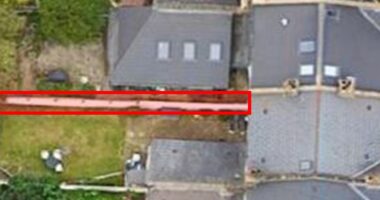


Flying high: Some trusts are now paying shareholders the equivalent of six per cent income a year
Although interest rates are rising – and savings rates tickling up – the case for the trusty share dividend remains robust.
According to data from wealth platform Interactive Investor, four of the ten most popular investment trusts bought by customers last month had an income bent.
Meanwhile, the latest sales statistics from the investment industry show that investors are now buying more global income funds than any other type of fund.
The surge of interest in equity income has been triggered by two key factors. First, volatile stock markets, resulting in investors seeking out equities that offer the comfort of a regular income to offset falling share prices.
Secondly, while interest rates have risen from 0.1 per cent in December last year to one per cent, they are still no match for the dividends paid by many companies, both here and overseas.
For example, the average dividend paid by companies making up the FTSE100 Index is equivalent to an annual income of 3.4 per cent.
‘Dividends provide a measure of protection amid stormy markets,’ says Kyle Caldwell, fund specialist at Interactive Investor. Yet even bigger dividend payments can be obtained if investors are prepared to spread their wings beyond the UK stock market – and in some instances take on board a little bit more investment risk.
Some stock market-listed investment trusts are now paying shareholders the equivalent of six per cent income a year, with payments often made on a quarterly basis.
They are digging out this income in various ways – by investing in dividend-friendly overseas companies, buying bonds rather than equities, or investing in income generating solar panels.
In some instances, the investment trusts are employing clever tactics to pay shareholders their returns – converting some capital gains into income payments or using income reserves accumulated over years to keep dividend payments sweet.
Of course, with inflation heading towards 10 per cent, these income payments cannot fully counter the impact of rising prices. But in most instances, shareholders can expect long-term growth in the capital value of their investments – even if markets fall further short-term. Here are six dividend-friendly investment trusts – all paying between 5.9 per cent and 7.9 per cent – that might not have popped up on your investment radar.
HENDERSON FAR EAST INCOME (7.9%)
This £453million trust invests across Asia with its biggest country exposure to mineral-rich Australia and Taiwan. Among its top holdings are mining giants Rio Tinto and BHP and electronics company Samsung.
Dividend growth is embedded in its investment objectives and to its credit it kept payments to shareholders growing throughout the pandemic. The result is a 15-year record of annual dividend increases, and it is well on course for another year of income growth.
In the trust’s current financial year ending August 31, it has so far paid two quarterly dividends of 5.9pence a share – compared to 5.8pence payments in the previous year.
The fund has the equivalent of nearly three quarters of a year’s dividend payments stored away in reserve – income that can be drawn upon to top up dividends to shareholders if key portfolio holdings come under pressure to cut their dividends. In terms of total return, the trust’s record is modest. Over the past five years, it has generated a return of nearly 12 per cent – less than four rival trusts investing in Asia for income.
Annual charges are a tad over one per cent and the stock market identification code is B1GXH75, the ticker HFEL.
EUROPEAN ASSETS (6.9%)
Run by investment house BMO Global Asset Management, this fund invests in small to medium-sized companies listed on European stock markets. It excludes UK investments.
Its portfolio comprises holdings unfamiliar to most UK investors – for example, tech stocks Lectra, Cancom and Alten, listed in France, Germany and France respectively. The trust has been hit by the worldwide share price correction in technology and growth companies (some 18 per cent of the portfolio is technology related). Over the past six months, it has generated losses of some 24 per cent. Five-year returns are around 7 per cent.
Irrespective of how its holdings are performing, the fund is committed to paying shareholders a high income – paid quarterly and equivalent to around six per cent a year. The dividends are funded from the income generated by its portfolio and also a return of capital.
It is primarily targeted at those wanting a consistently above average income rather than a growing one. In the current financial year, it has paid two dividends of 2.2pence a share with the shares trading at just above £1.
The trust’s annual charges are 0.94 per cent and the stock market code is BHJVQ59, the ticker EAT.
HENDERSON DIVERSIFIED INCOME (6.0%)
Unlike other high income trusts that are invested in equities, this £138million fund generates income from a portfolio of corporate bonds issued by UK and international companies.
Income is the priority with capital preservation – rather than capital return – being the order of the day. The trust holds bonds issued by familiar names such as Nationwide Building Society, Direct Line and insurer Phoenix. Its record of quarterly dividends is remarkable for its consistency. Once the final quarterly payment for the current financial year is paid at the end of this month, it means shareholders will have received annual dividends totalling 4.4pence for the fourth consecutive year. Shares are currently trading at around 74pence.
The trust is low risk and a good counterpoint to funds with an equity income bent. Its stock market code is BF03YC3 and ticker HDIV. Annual charges total 0.93 per cent which is high.
BLUEFIELD SOLAR INCOME (6.1%)
Launched in 2013, this £801million fund has provided a steady supply of income to shareholders. In the last financial year, it paid quarterly dividends totalling 8pence a year.
This year, its first two payments have increased slightly to a combined 4.06pence, and it hopes to pay a total of 8.16pence for the full financial year. The shares trade at around £1.30.
The income comes from the energy generated from a portfolio of solar farms it owns – which is then sold to suppliers. The trust has generated total returns over the past five years of 56 per cent. Its stock market code is BB0RDB9 and market ticker is BSIF.
JPMORGAN JAPAN SMALL CAP GROWTH & INCOME (6%)
This trust invests in small and medium-sized listed Japanese companies. It has had a tough six months, recording losses of more than 30 per cent. Yet it has a strong commitment to rewarding shareholders with relatively stable dividends, paid quarterly. These are paid from the dividends collected from its holdings, plus an element of capital return.
In the last financial year ending March 31, it paid dividends of 20.3pence, down on the previous financial year of 21.9pence, but an improvement on 2020 (17.7pence).
The shares currently trade at around £3.40, implying an annual income to shareholders in the order of 6 per cent. In the past five years, total returns of 11 per cent were generated by the trust.
The fund has assets valued at £183 million and the annual charges are 1.02 per cent. The stock market code is 0316581 and the ticker JSGI.
MONTANARO UK SMALLER COMPANIES (5.9%)
Although this trust is out of favour because of its focus on UK smaller companies, it has still managed to provide shareholders with a good income.
Dividends, for the year to the end of this March, totalled 6.44pence a share, up from 5.52pence in the previous financial year.
The trust’s shares are trading at around £1.10 – and stand at an attractive 14 per cent discount to the value of the underlying assets. In other words, they are cheap.
The stock market code is BZ1H9L8 and the ticker MTU. Annual charges total 0.99 per cent.









